The following concept against premature skin aging is based on the theory of corneotherapy. Corneotherapy is a new field of activity within the boundaries of dermatology and cosmetics and aims at a long term stabilization of the skin barrier (stratum corneum). A healthy and functioning skin barrier provides overall protection against dehydration, the penetration of germs, allergens, irritants, radicals and radiation. The protection supports a gradual healing of inflammations and other skin problems as the external causative agents are blocked off by an intact skin barrier.
It goes without saying that this apparently simple principle cannot resolve every potential skin problem. However, the studies of Professor A. Kligman could prove that already moisturizing substances may contribute to a high stabilization of the skin barrier and hence lead to clinically relevant results1,2). In this connection he coined the term "outside-in-therapy". Or, in other words, the long term effects in the epidermis ("in") after a therapeutic treatment of the horny layer ("outside") with appropriate skin caring substances can be compared with those known of topically active pharmaceuticals - without any side effects. Hence, it is obvious to adopt the principle of corneotherapy also for the supportive prevention of skin problems in the cosmetic skin care. The prevention of premature skin aging or anti-aging treatment is a consequence this context. Specifically within the field of anti-aging we also speak of "extended corneotherapy" if the horny layer is non-invasively opened for a limited period of time in order to infiltrate cosmetic agents like vitamins e.g. and then closed again. This procedure may also induce regenerative processes in areas below the stratum corneum without affecting the skin protection. Applied corneotherapy requires appropriately formulated cosmetic products, specific treatment methods and treatment-accompanying measures and may be classified as follows: -
Skin protection -
Supportive skin regeneration -
Individual treatment of skin problems -
Typical anti-aging actives -
Skin diagnosis - a precondition for the treatment -
Treatment procedures 1. Skin protection 1.1. Moisturizers
Moisturizers play a significant role in the skin. They increase the skin elasticity and smooth the skin. About 40 per cent of the NMF (natural moisturizing factor) consist of amino acids which are not only responsible for the moisture content of the skin but also for the osmolytic balance3), i.e. they correct imbalances in the osmotic pressure of the skin. The fact that the amino acids and the urea of the NMF also represent a natural protection against ROS (reactive oxygen species) i.e. against radicals is hardly known yet4). An example for the degradation of nitrite which is generated from nitrogen oxide radicals will explain the process. Scavenging by glycin: H2N-CH2-COOH + NO2- → HO-CH2-COO- + N2 + H2O
Scavenging by urea: H2N-CO-NH2 + 2 NO2- → CO32- + 2 N2 + 2 H2O If it is intended to replenish the NMF with skin care products it is recommended to use liposomes as transport systems as the phosphatidylcholine contained in their membranes is a skin-related substance. The transport mechanism will be explained at a later stage.
1.2. Derma Membrane Structure
The barrier layers of the stratum corneum mainly consist of ceramides, cholesterol and palmitic acid. They occur in form of bilayers. In this connection it suggests itself to use skin care products with the same or at least a similar composition which also form bilayers. These systems became popular under the name derma membrane structure (DMS). They usually contain ceramides, phytosterols (similar to cholesterol) and hydrogenated phosphatidylcholine with chemically bound palmitic and stearic acid. These components are physiological and integrate easily into the natural skin balance. The advantage of these systems is that they are free of emulsifiers which means that they definitely avoid the "wash-out" effect of conventional O/W emulsions as well as potential barrier disorders which may be observed in this context, a fact that is specifically important for persons with atopic skin5).
DMS structure as seen under the electron microscope (bar: 500 nm): 1.3. Sun protection
Intense sun radiation implies double stress for the skin with its UV- and its infrared-radiation (IR). While the skin can be protected with UV filters against UV radiation and melanomas, only adequate clothing and shade will help against infrared radiation. In this respect there is still need for detailed information as the infrared radiation is one of the main factors causing premature aging of the skin. If UV filters are used for sun protection they should be integrated into a DMS matrix and it is highly recommended to apply them only when definitely needed. A constant stress for the skin resulting from the use of day creams with UV filters should be avoided as they prevent the formation of the vitamins D2 (ergocalciferol) and D3 (cholecalciferol) in the long run. 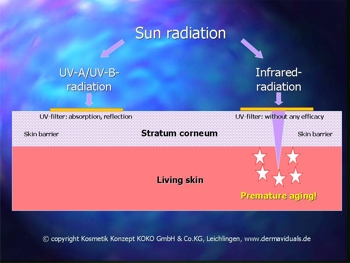 It is possible to reduce the sensitivity to sun radiation by adding CM-glucan to the creams as this active agent shows cell protective effects. It also slightly smoothes the skin and is an excellent additive for anti-aging base creams with a higher lipid content.
2. Supportive skin regeneration
2.1. Avoiding specific components
A major prerequisite for corneotherapy is that the different skin care components will definitely not affect the skin regeneration or cause skin reactions. It is therefore recommended to avoid the following components: -
Perfumes - the no.1 allergen in skin care products -
Preservatives - the allergen-causing substances no. 2 -
Mineral oil and non-volatile silicones - high concentrations can affect the skin regeneration -
Emulsifiers - may cause barrier disorders
2.2. Essential fatty acids
Linoleic acid (omega-6) is an essential corneotherapeutic component and usually applied in bound form as native phosphatidylcholine (liposomes, nanoparticles). It also exists in the stratum corneum as barrier active ceramide I:  Ceramide I deficits can lead to scaly skin with barrier disorders. Reduced concentrations of follicular lipids and of ceramide I also play a significant role in the comedogenesis in acne. Due to its linoleic acid content and the additional sebum suppressive influence, phosphatidylcholine is highly effective in first and second grade acne cases. Besides youth acne this also applies for the so called acne tarda at a later phase of life. Cornification disorders in general respond to this treatment.
Other important essential fatty acids are triple unsaturated γ-linolenic acid (omega-6) contained in evening primrose oil and α-linolenic acid (omega-3) contained in linseed oil. The 15-lipoxygenase (15-LOX) of the skin and the reduction that follows transform both the acids into very effective anti-inflammatory metabolites, i.e. 13-hydroxy-6,9,11-octadecatrienoic acid (13-HOTrEg) resp. 13-hydroxy-9,11,15-octadecatrienoic acid (13-HOTrE). And by the way, part of the linoleic acid will be transformed into the anti-inflammatory 13-hydroxy-9,11-octadecadienoic acid (13-HODE); 13-HODE inhibits the pro-inflammatory leukotrien LTB4. 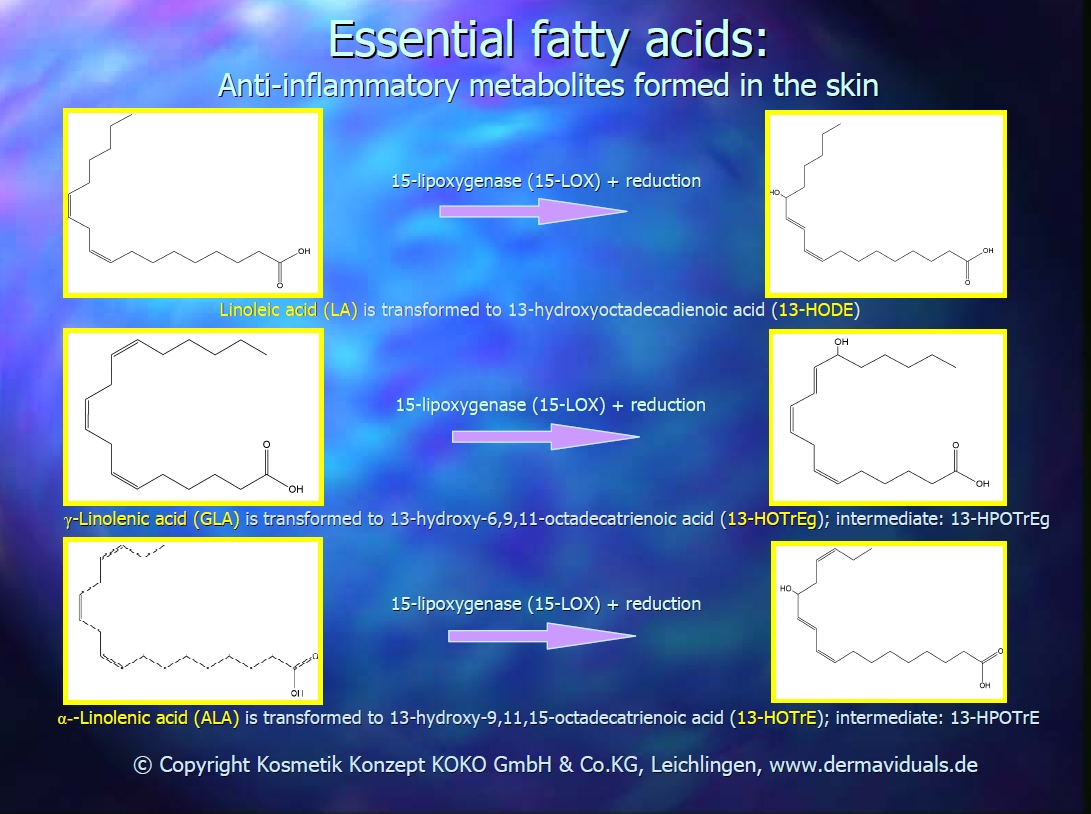 There is a fundamental difference between topical application of essential fatty acids and the oral intake as the liver passage in the latter case implies the formation of arachidonic acid (omega-6) resp. eicosapentaenoic acid (omega-3), which are metabolized among others into prostaglandins, thromboxanes, prostacyclines and leukotriens, all of them showing hormone-like effects. Atopic persons who quite frequently suffer from the enzyme deficit delta-6-desaturase benefit from the topical treatment with γ- as well as α- linolenic acid.
Rose hip oil has a 25 % content of α-linolenic acid. Oils with a significant percentage of linoleic acid are grape seed and wheat germ oil. The latter mentioned also has a 15 % content of barrier active palmitic acid similar to avocado oil with 20%. Just like the aforementioned oils, avocado oil is a powerful agent for the protection and natural regeneration of the skin due to its high content of phytosterols.
2.3. Carrier for regeneration supporting active agents6)
When revitalizing agents are used it depends on the specific carrier how the active agent is released. DMS and phosphatidylcholine containing non-aqueous oleogels with DMS components gradually release the active agents contained and hence provide a long term effect, whereas liposomes (with water soluble actives) and nanoparticles (with lipid soluble actives) disperse the active agents relatively quick into the horny layer and also the deeper skin layers. By adding DMS to the liposomes and nanoparticles the release rates can be influenced with the specific concentration. There are also mixtures of liposomes and nanoparticles ("semisomes") available. 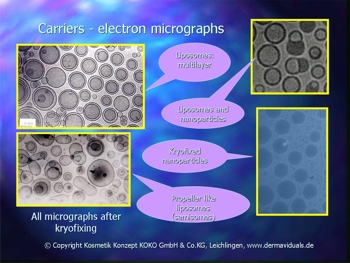 By the way, this technique may also be used to influence skin hydration and transepidermal water loss (TEWL) to a certain extent. It is primarily based on the fact that liposomes and nanoparticles do not penetrate the horny layer in form of particles but instead will modify the composition of the skin barrier layers by means of fusion which temporarily increases the permeability. This mechanism is illustrated in the following figure.  According to the principle of "extended corneotherapy" which will be explained in detail in the chapter "treatment measures", the permeability of barrier layers can again be reduced by the following application of DMS.
The typical manufacturing processes for skin care products frequently provide liposomes in a mixture of single and multi shell (lamellar) forms, whereas the lamellarity itself has no influence neither on storage capacity nor on the penetrating behavior. As already mentioned before in connection with the transport mechanism, only the concentration of native phosphatidylcholine in the liposome product is important.
2.4. Vitamins
The most frequently applied regeneration supporting substances are vitamins and related substances as well as their esters, which are released in the skin by enzyme reaction. The most significant substances in this context are -
Vitamin A - as acetate in nanoparticles -
Vitamin C - as phosphate in liposomes -
Vitamin E - as acetate in nanoparticles -
Yeast extract (B vitamins) - in liposomes -
Coenzym Q10 - in nanoparticles Properties and effects of the aforementioned vitamins have been discussed in detail in the respective literature. Concerning vitamin C it should be added that only low concentrations (0.5 %) are used in liposomes in order to activate the collagen in the skin and inhibit tyrosinase activity (important for laser treatments!). Conventional and highly dosaged non-liposomal solutions (10 % and more) only have keratolytic effects though.
2.5. Physical measures to support skin regeneration
Stimulating the microcirculation, preferably in form of accompanying corneotherapeutic measures, is a major element in the natural regeneration process of the skin. Regarding the treatment techniques, specifically massages should be mentioned, however, sport, physiotherapy as well as cold water showers also play their part. Cold water showers help improve the skin elasticity, not least due to the increased release of adrenal hormones.
3. Individual treatment of skin problems
In the following the most important active agents with specific skin care indications are mentioned. It is the objective here to guarantee a supportive prevention by means of cosmetic skin care as well as to preserve a well-functioning skin in the long run. Barrier disorders: -
Phytosterols - from shea butter or avocado oil (skin protection) -
Fumaric acid - liposomal (psoriasis) -
Aloe vera extract (dry and cracked skin) -
Hamamelis extract (dry and cracked skin) -
Evening primrose nanoparticles (atopic skin, dry skin) -
Linseed oil nanoparticles (atopic skin, dry skin) Cornification disorders: -
Phosphatidylcholine in form of liposomes, nanoparticles (acne, ichthyosis) -
Evening primrose nanoparticles (acne, anti-inflammatory) -
Linseed oil nanoparticles (acne tarda, anti-inflammatory) -
Vitamin A nanoparticles (acne, ichthyosis) Erythema, irritations -
Boswellia nanoparticles (anti-inflammatory by inhibiting the 5-lipoxygenase activity, actinic keratoses7)) -
Vitamin K nanoparticles (teleangiectases, couperosis, rosacea) -
Echinacea extract (teleangiectases, couperosis, rosacea, sun burns, perioral dermatitis) -
Evening primrose nanoparticles (anti-inflammatory effects) -
Linseed oil nanoparticles (anti-inflammatory effects) -
D-panthenol (stimulating the cell proliferation) -
CM-glucan (cell protective effects) In live cells phosphatidylcholine is responsible for the transformation of ceramides into sphingomyelins. The increase of ceramides there is an indication for the cell aging process.
4. Typical anti-aging actives
Among others, the term comprises active agents which may temporarily change the skin condition (smoothing, reduction of wrinkles etc.). Some substances also have a positive influence on the moisture balance of the skin, as e.g. hyaluronic acid and peptides. Following are some examples like -
Hyaluronic acid (skin-tightening) -
Para cress liposomes (reduction of wrinkles by relaxing muscle contractions) -
Peptides -
Palmitoyl-lysin-threonin-threonin-lysin-serin (influencing collagen synthesis) -
Acetyl-glutamic acid-glutamic acid-methionin-glutamic acid-arginin-arginin (reduction of wrinkles, similar to para cress) -
Green tea (improving the microcirculation) -
Grape seed extract liposomes (radical scavengers) -
Whitening liposomes (prevents hyper pigmentation by inhibiting tyrosinase activity) -
Phytohormones as e.g. red clover liposomes (estrogen like effects, cf. figure below) -
Special pigments - optical reduction of wrinkles by changed light reflection8) 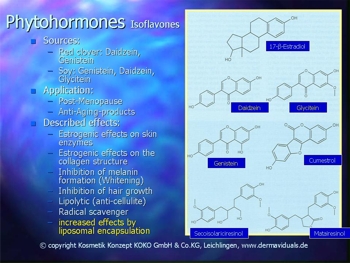 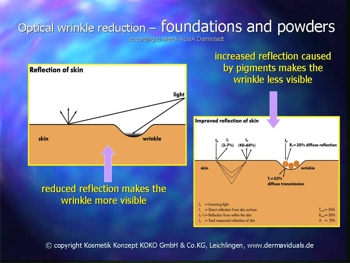 5. Skin diagnosis - a precondition for the treatment
It is absolutely essential to precisely diagnose the condition of the skin before an appropriate anti-aging treatment based on corneotherapy is applied. There is a whole variety of different procedures available. Already a detailed interview can provide significant information. Modular measuring instruments to diagnose skin hydration, lipid content, TEWL, elasticity, skin roughness, melanin and skin redness among others, already supply basic information which can be supplemented by evaluation of hormonal data and genetic measurements. 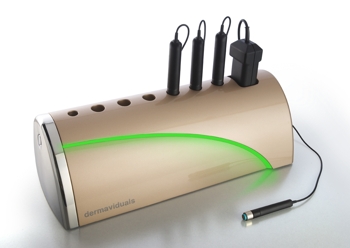 A continuously optimized treatment can be achieved by a long term evaluation of the interviews and measuring data based on interdisciplinary software. Translated into practice this means that the modular treatment method with corneotherapeutic products allows the individual adaptation to the particular condition the skin.
6. Treatment measures
As already mentioned above in connection with the penetration of liposomes, the skin barrier may be specifically adjusted to allow penetration (transport) or to a barrier function (skin protection).  This principle may be easily integrated into treatment procedures. An example for bad, dry and elderly facial skin reads as follows.
(a) Skin cleansing
Low-foaming liquid product (based on sugar tensides without re-fatteners)
(b) Peeling
Enzyme peeling (based on papaya, pineapple, clay minerals); remove after 10 min
(c) Toning
D-panthenol and liposome concentrate ("empty liposomes") prepare the horny layer for the penetration and already provide an increased dosage of linoleic acid)
(d) Active agents
- Linseed oil nanoparticles
- Red clover phytohormone liposomes
- NMF liposomes
The active agents are applied on the facial skin. After their absorption, a light avocado oil massage may follow and eventually a hardening modeling mask for a temporary covering.
(e) Closing treatment
DMS base cream with higher lipid content will re-close the skin.
(f) Home treatment
For the treatment at home the actives can also be mixed into the DMS base creams. The actives will be gradually released over a longer period of time depending on the concentration. The following formulation may serve as an example for the above mentioned type of skin: DMS base cream (91 %), linseed oil nanoparticles (5%), vitamin A nanoparticles (2%), para cress liposomes (2%).
7. References
-
Tabata N, O'Goshi K, Zhen YX, Kligman AM, Tagami H, Biophysical assessment of persistent effects of moisturizers after their daily Applications: Evaluation of Corneotherapy, Dermatology 2000;200:308-313 -
Lübbe J, Evidence-Based Corneotherapy, Dermatology 2000; 200:285-286 -
Yancey PH, Clark ME, Hand SC, Bowlus RD, Somero GN, Living with Water Stress: Evolution of Osmolytic Systems, Science 1982; 217: 1214-1224 -
Dröge W, Free Radicals in the Physiological Control of Cell Function, Physiol Rev 2002; 82: 47-95 -
Lautenschläger H, Membranhaltige Barrierecremes - wie die Haut, so der Schutz, Kosmetische Praxis 2006; 4: 12-14 -
Lautenschläger H, Liposomes, Handbook of Cosmetic Science and Technology (A. O. Barel, M. Paye and H. I. Maibach), 155-163, CRC Press Taylor & Francis Group, Boca Raton 2006 -
Jabs HU, Aktinische Keratosen - eine Volkskrankheit, Ästhetische Dermatologie 2005; 4: 31-32 -
Lautenschläger H, Schön, geschützt und gepflegt: Make-up für die Problemhaut, Kosmetische Praxis 2006; 6: 8-9 Dr. Hans Lautenschläger |

